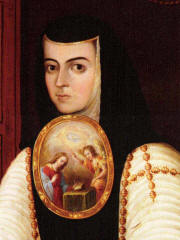

She resolved to be persevering and disciplined, to such an extent that, when she was still a young girl, she decidedly refrained from eating cheese, given that she happened to hear that it “made people rude”/2, that is, it made people behave in foolish ways.

After her mother’s refusal to do so, she found comfort in devouring books from her grandfather’s library. When she was seven, she learned about the University of Mexico, and asked her mother to send her there to study, even willing to be dressed as a man if necessary. Her curiosity was always behind her incentive to read and study. In an autobiographical document, the poet says that her love for the arts was born -as she puts it- “since the first light of reason crossed my mind”,/1 and that since she was three years old, following in her sister’s footsteps, she took classes and learned to read. She was creole, probably of Basque origin. To Paz her writings, like her life, epitomize the struggle of the individual, and in particular the individual woman, for creative fulfillment and self-expression.Juana Ramírez de Asbaje was born on Novem(or 1648) in San Miguel Nepantla in an estate located at the foot of the volcanoes. With critical authority he singles out the qualities that distinguish her work and mark her uniqueness as a poet. Just as Paz illuminates Sor Juana’s life by placing it in its historical setting, so he situates her work in relation to the traditions that nurtured it. Paz gives a masterly portrayal of the life and culture of New Spain and the political and ideological forces at work in that autocratic, theocratic, male-dominated society, in which the subjugation of women was absolute. Why did she become a nun? How could she renounce her lifelong passion for writing and learning? Such questions can be answered only in the context of the world in which she lived. Octavio Paz has long been intrigued by the enigmas of Sor Juana’s personality and career. Suddenly she surrenders her books, forswears all literary pursuits, and signs in blood a renunciation of secular learning. Her plays are performed, volumes of her poetry are published abroad, and her genius begins to be recognized throughout the Hispanic world. To the consternation of the prelates of the Church, she persists in circulating her poems, redolent more of the court than the cloister. Yet, no recluse, she transforms the convent locutory into a literary and intellectual salon she amasses an impressive library and collects scientific instruments, reads insatiably, composes poems, and corresponds with literati in Spain. For five years she enjoys the pleasures of life at court-then abruptly, at twenty, enters a convent for life.

She becomes known for her beauty, wit, and amazing erudition, and is taken into the court as the Vicereine’s protégée. A spirited and precocious girl, one of six illegitimate children, is sent to live with relatives in the capital city. His subject is Sor Juana Inés de la Cruz, the most striking figure in all of Spanish-American colonial literature and one of the great poets of her age. Mexico’s leading poet, essayist, and cultural critic writes of a Mexican poet of another time and another world, the world of seventeenth-century New Spain.


 0 kommentar(er)
0 kommentar(er)
